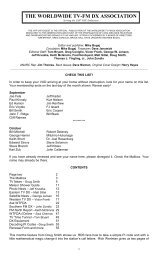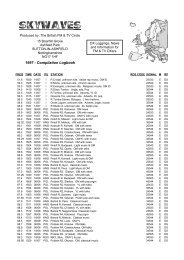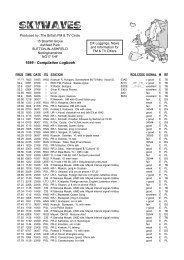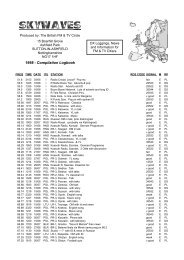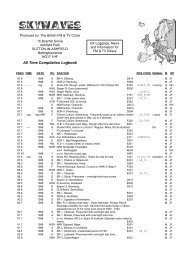1 Kenwood KT-815 (IF modified) w/6 element yagi indoors - DX Radio
1 Kenwood KT-815 (IF modified) w/6 element yagi indoors - DX Radio
1 Kenwood KT-815 (IF modified) w/6 element yagi indoors - DX Radio
You also want an ePaper? Increase the reach of your titles
YUMPU automatically turns print PDFs into web optimized ePapers that Google loves.
of the National Association of Broadcasters. If you have Adobe Acrobat Reader, you can<br />
read it for yourself on http://www.nab.org/scitech/rbds1998.pdf .<br />
As it turns out, in the United States there is a one-to-one relationship between PI codes<br />
and station call letters. If you receive a PI code, you can calculate which station transmitted<br />
it.<br />
A PI code is a four-digit "hexidecimal" number. In school, you may have learned about<br />
the different number bases. In the base 10 system we normally use in everyday life, the<br />
rightmost digit is the number of units - 10 to the 0th power. The next rightmost is the number<br />
of tens - 10 to the 1st power. Then, the number of hundreds - 10 to the 2nd power. And so<br />
on. In the binary number system, the rightmost digit is the number of units - this time, 2 to the<br />
0th. Then, the number of twos - 2 to the 1st - then the number of fours - 2 to the 2nd - etc.,<br />
etc..<br />
"Hexidecimal" is a fancy word for "base 16". In the "hex" number 7106, 6 is the number<br />
of units. There are no 16s (16^1), 1 256 (16 to the second power), and 7 4096s. (16 to the<br />
third power) Converting to decimal, you get:<br />
4096 * 7 = 28672<br />
256 * 1 = 256<br />
16 * 0 = 0<br />
1 * 6 = 6<br />
================<br />
28934<br />
(incidentially, there's an easier way to do this if you have Windows.. Click "Start",<br />
"Programs", "Accessories", "Calculator". Click "View", "Scientific". Click in the circle next to<br />
"Hex", and enter the hex number in the window above "Gradients". Click in the circle next to<br />
"Dec", and the number in the window is automatically converted to decimal.)<br />
Something I've glossed over is what's done with the "extra" digits. In the base 10<br />
number system, there are 10 possible digits: 0123456789. In the base 2 number system,<br />
there are 2 possible digits: 01. In base 16, there are 16 possible digits. We can call the first<br />
ten 0123456789, but what about the other six? We start using the alphabet. So the sixteen<br />
possible digits in the hexidecimal system are 0123456789abcdef. 21C7 is a valid hexidecimal<br />
number. (and it's equal to 8647 in base 10).<br />
The NAB assigned the PI code 1000 hex to the callsign KAAA. KAAB gets 1001,<br />
KAAC gets 1002, etc.. KZZZ works out to 54A7, so WAAA gets 54A8; WAAB 54A9, etc..<br />
There are a couple of exceptions to this orderly arrangement. For technical reasons too<br />
complicated to go into here (but explained in the NAB Web document) codes with 0 in the<br />
second digit like 80A3, and codes with 00 as the last two digits like 5300, don't work reliably.<br />
If the alphabetical system assigns a station 80A3, the zero is removed, the first digit<br />
moved one place to the right, and an A inserted as the first digit. 80A3 becomes A8A3. If the<br />
alphabetical system assigns 5300, *both* zeros are removed. The first two digits are shifted<br />
to the end, and AF inserted as the first two digits. 5300 becomes AF53.<br />
There are a handful of other exceptions. First, three-letter callsigns. These of course<br />
don't map into the four-letter alphabetical system the NAB set up. The codes between 9950<br />
and 9EFF have been reserved for these callsigns, and a specific lookup table has been<br />
established. KGO is 9954, WSM 99A4, etc.. For the most part, only three-letter calls that<br />
actually exist are in the table - though for some reason, the calls KBW, KCY, and KDF<br />
appear. To my knowledge these calls have *never* been assigned to broadcast stations.<br />
They have, however, been used as slogans by low-power TV stations and my bet is that's<br />
what's going on here.<br />
In some circumstances, it's desirable for several transmitters carrying a common<br />
program to use the same PI code. (it is, after all, *Program* Information, not *Station* or<br />
*Transmitter* Information) All codes beginning with B, D, and E have been reserved for<br />
multistation networks.<br />
33



